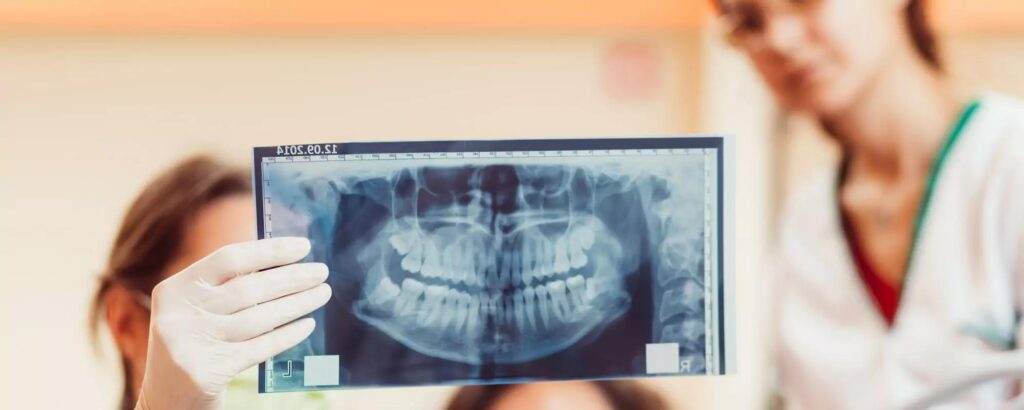
When you visit the dentist for a routine cleaning and examination, it’s common for x-rays to be part of the appointment. In-office imaging provides a closer look at your mouth, giving the dentist more information about potential issues that need to be treated in the early stages.
Are dental x-rays necessary? Even if you are proactive about consistent at-home brushing and flossing, x-rays are a recommended part of your checkup. Learn more about this imaging technology and you will understand the benefits of x-rays for your treatment plan.
Dental X-Rays: How They Work
X-ray technology has been around for many years. In the past, old technology used film and ionizing radiation to capture an image of the internal structure of the bones, teeth, and surrounding tissues.
Not only is x-ray technology helpful in a dental setting, but many doctors use x-rays to identify issues with broken bones, fractures, and more.
When an x-ray machine is used, it produces a small beam of x-ray photons that pass through the body. Then, a digital sensor captures images of the jaw and teeth showing physical structures including both soft and hard tissue.
In the x-ray image, soft tissues have lower density, so they show up with a gray background. On the other hand, calcium and minerals in teeth and bones show up as white, sharper shapes in the digital imaging.
There are two types of x-rays commonly used in the dental setting:
- Intraoral X-Rays: Digital sensors showing images of the inside of the mouth.
- Extraoral X-Rays: Sensors located outside of the mouth.
X-rays can be used to look closer at a specific area of the mouth. Or, panoramic imaging can be used with a full rotation around the head to capture a complete two-dimensional picture of the jaws and teeth.
Other common types of dental x-rays include occlusal x-rays showing the entire arch of the teeth in the jaw. Cephalometric x-rays capture an impact of the entre profile so the dentist can see the development of the jaws and teeth.
Finally, cone beam computed tomography is another form of digital imaging often used in the dental industry, creating a three-dimensional image of the teeth and jaws.
What Can a Dentist See on X-Ray Images
A dentist can complete a surface-level examination. But there is a lot going on underneath the teeth and gums that can’t be seen with the naked eye.
X-rays are helpful for evaluating a variety of details, including:
- The health, position, and size of the roots of the teeth.
- The position, shape, and size of your teeth.
- Positioning and anticipated movement of wisdom teeth and impacted molars.
- The shape and size of the jaw bones.
- Tooth alignment and how the jaws come together.
- Progress during various treatment plans.
Benefits of X-Rays for Early Detection
A visual examination only shows limited information about a given part of the body. When the doctor or dentist needs more information, then x-rays can provide an in-depth look at the targeted area. For example, dental x-rays help to improve diagnostics and treatment plans because the dentist can see what is going on with your teeth, jawbone, and gums.
Early diagnosis is more effective when dental x-rays are used. This technology helps the dentist identify common issues like gum disease, cavities, impacted teeth, bone loss, and more. When the dental team is proactive with early detection, then you have better long-term results because minimally-invasive treatments can be used before the situation progresses into a severe condition.
The benefits of using dental x-rays include:
- Early Detection: Identifying potential issues in the earliest stages, which improves treatment outcomes.
- Lower Costs: When early treatments are used, it helps to minimize overall costs since you can avoid the development of more serious issues that require in-depth treatments.
- Changes in Dental Health: Regular x-rays allow the dentist to identify any changes in your dental health, including tooth decay or the structure of your jawbone. For example, comparing x-rays can uncover bone loss that is occurring.
- Personalized Treatment Planning: In-depth information from dental x-rays makes it easier to take care of many common problems, including gum disease and cavities.
- Treatment Progress: If you are receiving treatment for any dental conditions, then x-rays can be helpful to track progress and ensure that your mouth is healing properly.
X-ray technology is an important step to help you maintain good dental health. When the doctor has detailed information about the internal structures within your mouth, then dental problems can be addressed and treated more effectively.
How Often Do You Need Dental X-Rays?
In most situations, dentists recommend x-rays 1 – 2 times per year. For example, a patient with good health overall likely only needs x-rays once a year. Which means this imaging technology is used at every-other appointment when the person is visiting the dental office every six months.
But if someone is at risk for dental complications, or they are receiving treatments for certain conditions, then there are times when the dentist will recommend more frequent x-rays.
This imaging should be used as recommended by your dentist, based on your unique health conditions and needs.
Modern X-Rays: Digital Imaging and Less Radiation
Some people are concerned about radiation exposure when x-ray imaging is used. The truth is that modern technology has drastically reduced the amount of radiation necessary to capture these digital images.
In fact, digital imaging today requires 90% less radiation compared to the old film technology used in the past. Fast imaging allows for shorter exposure times.
Even though radiation levels are much lower compared to past technology, we are still proactive about using protective equipment. You will wear an apron shield to keep the radiation exposure away from major organs.
So, you can have peace of mind knowing that x-rays are much safer today compared to the machines used years ago.
Schedule a Cleaning and Examination
Is it time for you to visit the dentist for a routine examination? Our team is here to help with full-service dental treatments. We invite you to contact Cosmetic & Family Dentistry of Las Colinas to book an appointment and learn more about the services we provide.
- Awareness16
- Bad Breath1
- Bone Grafting1
- Braces4
- Causes, Symptoms, And Treatments6
- Cavities5
- Chewing Gum1
- Cosmetic Dentistry of Las Colinas15
- COVID-192
- Deep Cleaning7
- Dental Anxiety1
- Dental Bridge2
- Dental Care27
- Dental Cleaning6
- Dental Crown1
- Dental Filling1
- Dental Health24
- Dental Implants6
- Dental Sedation1
- Dental Visit1
- Dental X Ray3
- Floss1
- Gum Dieseases4
- Injury1
- Insurance1
- Invisalign8
- Oral Cancer1
- Oral Hygiene24
- Root Canal9
- Sleep Apnea2
- Tartar1
- Teeth19
- Thanksgiving1
- TMJ1
- Tongue1
- Veneers2
- White Teeth12
Get Your Best Smile With Us
